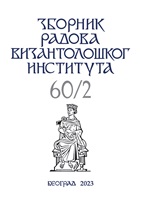СЛИКАРИ У ВИЗАНТИЈИ И ЗЕМЉАМА У ЊЕНОМ ОКРУЖЕЊУ – ЊИХОВ ДРУШТВЕНИ СТАТУС И УГЛЕД
PAINTERS IN BYZANTIUM AND BEYOND – THEIR SOCIAL STATUS AND REPUTATION
Author(s): Miodrag MarkovićSubject(s): Cultural history, Visual Arts, Social history, Sociology of Art, History of Art
Published by: Vizantološki institut SANU
Keywords: medieval painters; social status; Byzantine art; Byzantine Commonwealth; amateur painters; clerics-painters; self-awareness of painters; painting apprentices;
Summary/Abstract: The paper examines the social position and reputation of artists, primarily painters, in Byzantium and the countries under its cultural influence, in the area of the socalled Byzantine Commonwealth. It concludes that painters were treated like all other craftsmen in many aspects of social life from the time of the Book of Eparch (from the tenth century). Nevertheless, some artists were highly respected, and this prestige manifested itself in different ways: prominent painters were praised for their artistic skill or their wisdom and education, some were engaged as witnesses or guarantors in court cases due to their civic and personal credibility, some enjoyed a reputation that stemmed from their other profession – many of them were members of the clergy (priests, hieromonks, monks, hegoumenoi, chartophylaxes, metropolitans), some were elected state, city or military officials, and judges, and some were sent on diplomatic missions. Accordingly, many painters were addressed by the title kyr (Sir), which also testifies to their reputation and social status. Others, however, were forced to earn a living by trading, sometimes even by farming or herding. On the other hand, sources testify that occasionally figures of the highest social ranks (emperors, archbishops, metropolitans, nobles) also dabbled in painting, but they usually did so for fun, and are thus rightly seen in scholarship as amateur painters and cannot be used to illuminate the social status of painters. It seems, however, that the artist’s reputation, about which this paper provides original testimonies and a range of other indicators, generally did not bring a better or higher social status to the painters themselves, so until the end of the Middle Ages, much as in the tenth century, as evidenced by the Book of Eparch, they retained the status of artisans. To corroborate that claim, the paper brings original data on the social strata from which apprentices in painting workshops were recruited and the social circles from which came the spouses of painters or their family members.
Journal: Зборник радова Византолошког института
- Issue Year: 2023
- Issue No: 60/2
- Page Range: 1213-1246
- Page Count: 34
- Language: Serbian

